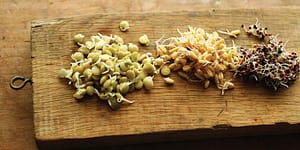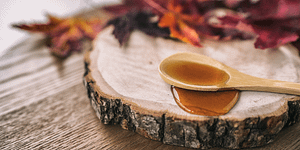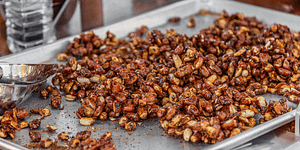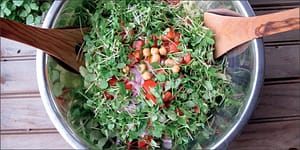Preserving Vegetables in Salt: Whole Tomatoes

Buying fresh produce feels like a waiting game — if you blink, your food will go from ripe to rotten all too soon. Beat this game by preserving vegetables, such as tomatoes, in salt. This process will keep them fresh and ready for sauce, stock, and more.
The following is an excerpt from Preserving Food Without Freezing or Canning by The Gardeners & Farmers of Terre Vivante. It has been adapted for the web.
Preserving Vegetables in Salt
Above a certain concentration of salt in food, microorganisms cannot develop and thus the preservation of food is assured.
While preserving with salt seems a relatively ancient process, it is not as old as [other] methods…At one time, salt was mainly used for preserving meat, fish, and butter; every rural household had a salt tub. Today, salt still is used for fish, such as cod or anchovies, as well as for pork and butter. Among vegetables, we sometimes salt green beans, herbs, and vegetable mixtures for soup stock.
What to Know Before Preserving Vegetables
There are two main disadvantages to preserving food with salt:
- The salt must be removed from most foods before consuming them, which usually requires lengthy soaking and repeated rinsing that also eliminate some of the nutrients;
- If the salt is not completely removed, we risk consuming more than is considered healthy these days.
However, for preserving foods that we eat in small quantities, or that don’t need much soaking and rinsing, salt has its place. It is one of the best ways to preserve fish, for which other methods tend to be less convenient. Green beans seem to be the vegetable that best lends itself to being preserved with salt.
Preserve Mixed Vegetables In Salt
There are many versions of this method of preservation, and we have included in this chapter several of the most common ones. Yet, among all the foods preserved with salt, mixed vegetables are perhaps the most appealing: no salt need be removed; they do not cause you to eat too much salt; and they make instant stock for soup.
 Preserving Whole Tomatoes
Preserving Whole Tomatoes
Ingredients
- Tomatoes
- Olive oil
- Salt
- A saucepan
- Glass jars and lids
Procedure
- Make a brine (one-quarter cup salt to one quart of water), and bring it to a boil.
- Allow to cool.
- Choose firm tomatoes, preferably (‘Campbell’ variety, for example), wash and dry them carefully, and put them in glass jars.
- Pour in the cooled brine, up to one and a quarter inches below the rim, and fill in the remaining space with olive oil to cover.
- Close the jars airtight and store them in a cool place.
These tomatoes will keep for nine to ten months; use them for sauces.
Recommended Reads
Recent Articles
What’s so great about oyster mushrooms? First, you can add them to the list of foods that can be grown indoors! They are tasty, easy to grow, multiply fast, and they love a variety of substrates, making oyster mushrooms the premium choice. The following is an excerpt from Fresh Food from Small Spaces by R. J.…
Read MoreCraving something sweet? These delicious maple roasted nuts are the perfect treat to help you push through those end-of-winter blues. The following is an excerpt from Full Moon Feast by Jessica Prentice. It has been adapted for the web. The Magic of Maple: A Rich History Following the Hunger Moon, just before the first thaw…
Read MoreDoes the cold weather have you dreaming about fresh greens and colorful salad? Grow and harvest sprouts indoors to make those dreams a reality! Follow this quick start guide to year-round greens for fresh salad greens in just a couple of weeks! The following is an excerpt from Year-Round Indoor Salad Gardening by Peter Burke. It…
Read More
 Preserving Whole Tomatoes
Preserving Whole Tomatoes






